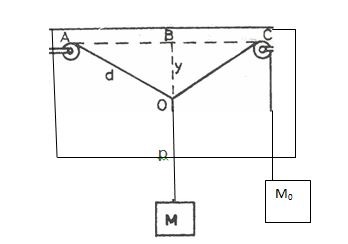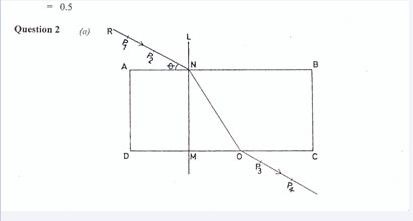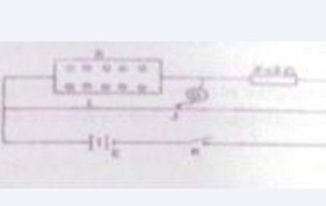NECO Physics Practical Answers 2023 Released Here.
The Neco physics practical 2023 answers are now available. The National Examination Council (NECO) Senior School Certificate Exam (SSCE) Physics Practical paper will be written on Tuesday 18th July 2023.
The Neco Physics Practical exam will commence from 10:00 am to 12:45 pm. The Neco physics practical is usually divided into 3 questions (comprising of Mechanics, Waves, and Electricity) with a few other general knowledge calculations added.
Here is a sample of the Neco physics practical answers and solutions from Neco physics past questions. The provided materials and apparatus for the practical physics exam are as follows;
- Two Retort stands, Drawing board, Fixed Pulley, Drawing papers, Four Thumb pins, Masses (30,20,10 and 5g), Mass =30g covered and labeled W, Mass hanger, and Twine.
- Rectangular glass prism, Four optical pins, Drawing board, Drawing papers, and Four Thumb pins.
- 2Ω standard resistor covered and labeled X, Resistance box, Meter bridge, Galvanometer, Jockey, 2V accumulator or two × 1.5V laclanche cells, Key, and connecting wires.
NECO Physics Practical Questions.
QUESTION 1:
(a) Diagram

Using the above diagram as a guide, carry out the following instructions.
i. Attach the mass Mo to one end of the thread provided. Fix the other end of the thread to the pulley on the force board. Pass the thread through pulley C.
ii. Hang the force board vertically. Fix a drawing paper on the board behind the thread.
iii. Draw a line on the paper along the direction of AC. Locate and mark the mid point B of line AC.
(iv)Draw a normal to AC at B.
v. By means of a loop of thread, suspend mass M = 70 g from AC. Adjust the position of the loop so that the line of action of the weight of M lies along with BP, the normal to AC.
vi. Ensure that M and Mo hand off the force board. Trace the paths AO, OC, and OP of the thread.
vii. Measure and record y = BO. Also, measure and record d = AO.
viii. Evaluate 1 = y /d
ix. Repeat the procedure for other values of M = 100, 120, 150 and 170g.
x. Tabulate your readings.
xi. Plot a graph with I on the vertical axis and M on the horizontal axis.
xii. Determine the slope, s, of the graph.
xiii. State two precautions taken to ensure accurate results.
(attach your traces to your answer booklet.)
(b) i. State parallelogram law of vector addition.
ii. State the conditions necessary for a body to be in equilibrium when acted upon by a number
of parallel coplanar forces.
QUESTION 2:
(a) Diagram

Use the diagram above as a guide to carry out the following experiment.
i. Trace the outline ABCD of the rectangular glass prism on the drawing paper provided.
ii. Remove the prism. Select a point N on AB such that AN is about one quarter of AB.
iii. Draw the normal LNM. Also, draw a line RN to make an angle θ = 75o with AB at N
iv. Fix two pins at P1 and P2 on line RN. Replace the prism on its outline.
v. Fix two other pins at P3 and P4 such that they appear to be in a straight line with the images of the pins at P1 and P2 when viewed through the prism from side DC.
vi. Remove the prism and the pins at P3 and P4 Draw a line to join P3 and P4.
vii. Produce line P4P3 to meet the line DC at O. Draw a line to join NO.
viii. Measure and record the values of MO and NO.
ix. Evaluate ф = and cos θ.
x. Repeat the procedure for four other values of θ – 65o, 55o, 45o, and 35o. In each case, evaluate ф and cos θ
xi. Tabulate your reading
xii. Plot a graph with cos θ on the vertical axis and ф on the horizontal axis.
xiii. Determine the slope, s, of the graph.
xiv. Sate two precautions that are taken to ensure accurate results.
(Attach your traces to your answer booklet)
(b) i. State Snell’s law of refraction.
ii. Calculate the critical angle for the glass prism used in the experiment above if its refractive index is 1.5.
RELATED: NECO PHYSICS QUESTIONS AND ANSWERS
QUESTION 3:

(a) You are provided with a meter bridge, standard resistor X galvanometer. jockey, cells, a key resistance box, and some connecting wires.
i. Connect the circuit as shown above.
ii. With R set to 10 Q obtain a balance point J on VB
iii. Measure and record length AJ =L
iv. Evaluate L-1 and R-1
v. Repeat the procedure with values of R = 20 Ω, 30 Ω, 40 Ω, 50 Ω, and 6O Ω
vi. In each case, measure and record L and evaluate L-1 and R-1
vii. Tabulate your readings.
viii. Plot a graph with L-1 on the vertical axis and R-1 on the horizontal axis
ix. Determine the slope, s, of the graph and the intercept, i. on the vertical axis
x. Evaluate the quantities.
(α) Q, = 100s,
(β) Q2 = i-1
xi. State two precautions taken to ensure accurate results.
(b) i. State Ohm’s law.
ii. Calculate the resistivity of a wire of length 1 0m* diameter 7 0 x 10“* m and electrical resistance of 1.00.
Keep following and bookmark this page. We will be updating them with more questions…

Are this questions correct?
Hi pls send me NECO answer on physics
Is this for 2022 neco
Is this the real question
Yes we need physics practical answer
I need answers
😭
Pls is this for neco gce 2021
Thanks so much
Great job guys
how can you send for me the answer before the exam started????
I need physics practical answer
I need physic practical answer
You are great I believe even today will be good
What about the answers in physics practical ,less i forget i really appreciate you guys had been of help all this while i love you all thanks.
Are this question correct????
Yes
U are right o
Go and read ooooo u never can tell, u might have another invigilator outside ur school oooo, I don’t want to forget what am reading here ooo
Go and read ooooo u never can tell, u might have another invigilator outside ur school oooo
The re correct
How do we know if the questions here r correct
The questions there is how the physics practical questions will look like
U are right o
I need physic practical answer
how many % sure r u sir that dis questions r d correct ones
how many % sure that dis questions r d correct ones
No put your mind oo
we should really thank this website cos the practical chemistry I studied here and with myschoolblaze, I was able to write without any help
Me na any one I see i go write